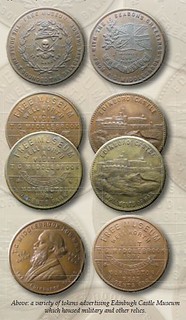
PREV ARTICLE
NEXT ARTICLE
FULL ISSUE
PREV FULL ISSUE
DATING THOMAS GEORGE MIDDLEBROOK'S TOKENSDavid Powell submitted these thoughts on Thomas George Middlebrook's tokens. Thanks! -Editor
I believe that the earliest one is that depicting the castle, before he acquired the five auks' eggs, the Chesapeake flag and the Balaclava bugle which seem to loom large as the centrepieces of his collection. The Windsor, Pembroke, Edinburgh and Dublin Castles were four public houses set up in different parts of 19th cent Camden, initially for the purposes of keeping apart the different groups of English, Welsh, Scottish and Irish navvies, respectively, who were at that time building the railways of North London, and between whom there was frequent racial tension, especially when under the influence of alcohol. Middlebrook was a publican by profession, first and foremost, from at least the date of his marriage {1874} until his death. The electoral registers confirm 1879 as being the likely year of his arrival at the Edinburgh Castle, probably from Southwark, but I am not wholly convinced that the museum was active that early. It may be, for example, that Middlebrook did not progress his antiquarian interests seriously until after the death of his wife in 1887, when he might have been looking for some alternative activity to occupy his mind. The date on the castle piece could be intended as a foundation date, to convey a sense of longer establishment for the museum than was actually the case. Middlebrook developed an obsession with the eggs of the Great Auk, a species of bird which went extinct in the mid-19th cent. There were only about 75 known eggs in existence and Middlebrook reputedly had it as an ambition to acquire ten of these. In the eventuality, he got five, four of which {believed to be the first four} were acquired at auction in London in April 1895, April 1897, July 1897 and July 1899 at a cost of 180, 280, 160 and 300 guineas respectively. Piece 2, in which Middlebrook's head combines with the original reverse, mentions one of these eggs, and was probably issued to celebrate its acquisition; hence probably 1895. The Victorian Jubilee piece is no.3 in the sequence, not the last; the price of the egg is stated on the piece as being 280 guineas, and hence relates to that acquired in April 1897. "Last in sequence is the piece which mentions the flag and bugle for the first time, as well as an unspecified auk's egg, said to be "the largest egg in the world". This probably means the 300 guinea one acquired in April 1899, although this is not certain. Regarding the other items, the Balaclava bugle was not acquired until March 1898; until his death in 1893 it was the property of Trumpet-Major Henry Joy, the soldier who originally sounded it in the Crimea all those years before. I do not know exactly when the Chesapeake flag was purchased, but an American newspaper suggests that it was in 1899. The likelihood is that piece 4, with its Christmas message, was issued near the end of that year." Middlebrook's activities seem to go quiet after the end of 1899, probably because his ambition was outstripping his ability to finance and accommodate them. When he died, his assets amounted to only £811, just a little more than he had paid for the bugle. It is likely that he was in serious debt, and that most of his estate went into paying it off. The largest egg and the bugle both made substantial losses when auctioned in 1908, although the American interest in the Chesapeake flag ensured that one item, at least, attracted lively bidding. There were doubts expressed in the press at the time over whether some of the items, particularly the bugle and four of the auks' eggs, were genuine. There is an article on Middlebrook and his museum in the Harmsworth London Magazine, Vol.3, p.396-400, written in November 1899. His bidding at auction was sometimes considered outrageous, and attracted the attention of the press on a number of occasions; in consequence of which there are also quite a number of references in the British Newspaper Archive http://www.britishnewspaperarchive.co.uk/ . One American author, George Webb Appleton, even wrote him into a novel: http://gutenberg.spiegel.de/buch/das-halsband-des-kaisers-7426/13 To read the earlier E-Sylum article, see:
Wayne Homren, Editor The Numismatic Bibliomania Society is a non-profit organization promoting numismatic literature. See our web site at coinbooks.org. To submit items for publication in The E-Sylum, write to the Editor at this address: whomren@gmail.com To subscribe go to: https://my.binhost.com/lists/listinfo/esylum All Rights Reserved. NBS Home Page Contact the NBS webmaster 
|
